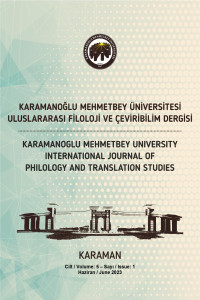GEOFFREY CHAUCER’IN THE HOUSE OF FAME VE THE PARLIAMENT OF BIRDS ESERLERİNDE ORTA ÇAĞ HAYVAN SEMBOLİZMİ GELENEĞİ
Öz
Açıklamalar ve çizimler ile hayvanlar hakkında bilgi veren bir katalog niteliği taşıyan ve İngilizce bestiary olarak bilinen ‘hayvan sembolizmi’ kitapları Orta Çağ’da oldukça yaygındır. Varlık zincirinde insana en yakın olarak yaratılan ‘hayvan’ eski zamanlardan beri insan yaşamında büyük bir rol oynamış çoğu zaman insanlara yiyecek ve giyecek sağlayarak yaşamlarını kolaylaştırmıştır. Öte yandan Orta Çağ’da çoğunlukla tarım ve ulaşımda kullanılmaya başlanan hayvanlar, yalnızca birer av olmaktan öteye geçerek yaşamın her alanında insanların yanında olan en sadık dostlarına dönüşmüştür. Hayvanların insan yaşamında bu denli büyük bir role sahip olması insanların bu varlıkları tanıma isteğini arttırmış bu da hayvan motiflerinin ve sembolizmin edebiyatta da sıkça kullanılmasına neden olmuştur. Özellikle o dönemde oldukça popüler olan alegori ve sembolizm etkisi hayvanlara çeşitli mistik ve ruhani anlamlar atfedilmesine ve edebi eserlerde sıklıkla kullanılmalarına ortam hazırlamıştır. Hayvan sembolizmi, böylelikle, din olgusunun hâkim olduğu Orta Çağ’da din ve ahlak dersleri vermede önemli bir araç haline gelmiş ve birçok edebi esere esin kaynağı olarak oldukça popüler bir geleneğe dönüşmüştür. Bu bağlamda Orta Çağ’daki bestiary geleneğinden yola çıkan bu çalışma İngiltere’nin ve İngiliz edebiyatının ilk büyük şairi olarak addedilen Geoffrey Chaucer’ın (1340-1400) The House of Fame (Şöhret Evi) ve The Parliment of Birds (Kuşlar Meclisi) eserlerinde hayvan sembolizminin izini sürmektedir. Böylelikle, çalışma Chaucer'ın hayvan sembolizmi mirasını bazen Orta Çağ'ın Hristiyan öğretilerinin merkezinde yer alan geleneğin aksine didaktik kaygı gütmeden okuyucuyu sadece eğlendirmek bazen de dinin yanı sıra bilimsel konularda bilgilendirmek için kullanarak, geleneğe farklı bir bakış açısı getirdiğini göstermeyi amaçlamaktadır.
Anahtar Kelimeler
Geoffrey Chaucer The Parliament of Birds The House of Fame hayvan sembolizmi bestiary
Kaynakça
- Barber, R. (1993). Bestiary: Being an English Translation of the Bodleian Library, Oxford M. S Bodley 764.Woodbridge: Boydell Press.
- Baum, F. P. (Dec., 1941). “Chaucer's The House of Fame”. ELH. 8: 4, 248-256, The Johns Hopkins University Press: JSTOR, http://www.jstor.org/stable/2871581
- Baxter, R. (1998). Bestiaries and Their Users in the Middle Ages. Gloucestershire: Sutton Publishing,
- Chaucer, G. (1987). “The House of Fame”. Love Visions. Çev. Brian Stone. New York: Penguin Books.
- Chaucer, G. (2006). Canterbury Hikayeleri. Çev. Nazmi Ağıl. İstanbul: Yapı Kredi Yayınları.
- --------, (1987). “The House of Fame” Love Visions. Çev. Brian Stone. New York: Penguin Books.
- --------, (1987). “The Parliament of Birds”. Love Visions. Çev. Brian Stone. New York: Penguin Books.
- Clark, W. B. ve M. T. McMunn, (Ed.) (1989). Beast and Birds in the Middle Ages: The Bestiary and Its Legacy. Philedelphia: University of Philedelphia Press.
- Cranin, G. (1941). The Bestiary and the Medieval Mind-Some Complexities. Modern Language Quarterly II. 191-98.
- Colins, A. (1913). Symbolism of Animals and Birds Represented in English Church Architecture. M.S Tezi. New York: McNBride, Nast & Company.
- Cowgill, B. K. (1975). The “Parlement of Foules” and the Body Politic. The Journal of English and Germanic Philology, 74(3), 315–335. http://www.jstor.org/stable/27707923.
- Evans, E. P. (1896). Animal Symbolism in Ecclesiastical Art. New York: Harry Holt.
- Kaya, M. (2014). “Aristoteles‟in Ruh Anlayışı”. Pamukkale Üniversitesi Sosyal Bilimler Enstitüsü Dergisi Sayı 18, 91-98.
- Kerns, B. (2011). “Gregory the Great and The Bestiary”. Cistercian Studies Quarterly; 46:4, 403.
- Kiser, J. L. (2001). “Chaucer and the Politics of Nature”. Beyond Nature Writing: Expanding the Boundaries of Ecocriticism. (Ed.) Karla Armbruster ve Kathleen R. Wallace. Charlottesville: The University Press of Virginia.
- McGerr, R. P. (1998). Chaucer's Open Books: Resistance To Closure In Medieval Discourse. Gainesville: University Press of Florida. eBook Academic Collection (EBSCOhost). Web. 26 May 2015.
- Olson, P. A. (1980). “The Parlement of Foules: Aristotle's Politicsand the Foundations of Human Society”. SAC 2, 53-80. Web. 29 Mayıs 2023.
- Overbeck, P. T. (1975). "Man of Gret Auctorite" in Chaucer's "House of Fame". Modern Philology 73: 2, 157-161. The University of Chicago Press Stable, JSTOR, http://www.jstor.org/stable/436330.
- Payne, A. (1990). Medieval Beasts. New York: New Amsterdam Press.
- Powrie, S. (2010). "Alan Of Lille's Anticlaudianus As Intertext In Chaucer's House of Fame." Chaucer Review 44.3: 246-267. Art Source. Web. 25 May 2015.
- Rothschild, V. (May, 1984). “The Parliament of Fowls: Chaucer's Mirror up to Nature?” The Review of English Studies, New Series, 35: 138, 164-184.
- Salisbury, J. (2011). The Beast Within: Animals in the Middle Ages. London: Routledge.
- Schibanoff, S. (2006). Chaucer's Queer Poetics: Rereading The Dream Trio. Toronto: University of Toronto Press, eBook Academic Collection (EBSCOhost). Web. 27 May 2015.
- Stone, B. (1987). “Introduction to The House of Fame”. New York: Penguin Books.
- Van D., C. (2012). “Introduction: In Hir Corages: Chaucer and the Animal Real”. Rethinking Chaucerian Beasts. London: Palgrave Macmillan.
- White, T. H. (1960). The Bestiary: A Book of Beasts. New York: Capricorn Books.
- Windeat, B. (2006). “Courtly Writing”. A Concise Companion to Chaucer. Ed. Corainne Saunders. Oxford: Blackwell Publishing.
Öz
Books on animal symbolism, the catalogues including data on many animals together with descriptions and illustrations also known as bestiaries in English, were quite common during the Middle Ages. The 'animal', which was created as the closest to humans in the chain of beings, has made life easier for humans since ancient times especially by providing them with food and clothes. In the Middle Ages, however, most of these animals were employed for agriculture and transportation which turned them into the most devoted friends of human more than just preys. Thus, people’s desire to know animals better increased. This led to the frequent use of animal motifs and symbolism in literature as well. Especially with the influence allegory and symbolism, which were quite popular at the time, various mystical and spiritual meanings were ascribed to animals. In the Middle Ages marked by religion, animal symbolism became a crucial medium for teaching religion and morality as well as a source for inspiration for many literary works. Based on the Medieval bestiary tradition this study traces animal symbolism in The House of Fame and The Parliament of Birds by Geoffrey Chaucer (1340-1400), who is regarded as the first great poet of English literature. In so doing, the study aims to demonstrate how Chaucer contributed a unique viewpoint to the tradition at the core of Middle Ages Christian teachings, sometimes using his legacy of animal symbolism to entertain the reader without any didactic concern and other times to educate them on various scientific topics as well as religion.
Anahtar Kelimeler
Animal symbolism Bestiary Geoffrey Chaucer The House of Fame The Parliment of Birds
Kaynakça
- Barber, R. (1993). Bestiary: Being an English Translation of the Bodleian Library, Oxford M. S Bodley 764.Woodbridge: Boydell Press.
- Baum, F. P. (Dec., 1941). “Chaucer's The House of Fame”. ELH. 8: 4, 248-256, The Johns Hopkins University Press: JSTOR, http://www.jstor.org/stable/2871581
- Baxter, R. (1998). Bestiaries and Their Users in the Middle Ages. Gloucestershire: Sutton Publishing,
- Chaucer, G. (1987). “The House of Fame”. Love Visions. Çev. Brian Stone. New York: Penguin Books.
- Chaucer, G. (2006). Canterbury Hikayeleri. Çev. Nazmi Ağıl. İstanbul: Yapı Kredi Yayınları.
- --------, (1987). “The House of Fame” Love Visions. Çev. Brian Stone. New York: Penguin Books.
- --------, (1987). “The Parliament of Birds”. Love Visions. Çev. Brian Stone. New York: Penguin Books.
- Clark, W. B. ve M. T. McMunn, (Ed.) (1989). Beast and Birds in the Middle Ages: The Bestiary and Its Legacy. Philedelphia: University of Philedelphia Press.
- Cranin, G. (1941). The Bestiary and the Medieval Mind-Some Complexities. Modern Language Quarterly II. 191-98.
- Colins, A. (1913). Symbolism of Animals and Birds Represented in English Church Architecture. M.S Tezi. New York: McNBride, Nast & Company.
- Cowgill, B. K. (1975). The “Parlement of Foules” and the Body Politic. The Journal of English and Germanic Philology, 74(3), 315–335. http://www.jstor.org/stable/27707923.
- Evans, E. P. (1896). Animal Symbolism in Ecclesiastical Art. New York: Harry Holt.
- Kaya, M. (2014). “Aristoteles‟in Ruh Anlayışı”. Pamukkale Üniversitesi Sosyal Bilimler Enstitüsü Dergisi Sayı 18, 91-98.
- Kerns, B. (2011). “Gregory the Great and The Bestiary”. Cistercian Studies Quarterly; 46:4, 403.
- Kiser, J. L. (2001). “Chaucer and the Politics of Nature”. Beyond Nature Writing: Expanding the Boundaries of Ecocriticism. (Ed.) Karla Armbruster ve Kathleen R. Wallace. Charlottesville: The University Press of Virginia.
- McGerr, R. P. (1998). Chaucer's Open Books: Resistance To Closure In Medieval Discourse. Gainesville: University Press of Florida. eBook Academic Collection (EBSCOhost). Web. 26 May 2015.
- Olson, P. A. (1980). “The Parlement of Foules: Aristotle's Politicsand the Foundations of Human Society”. SAC 2, 53-80. Web. 29 Mayıs 2023.
- Overbeck, P. T. (1975). "Man of Gret Auctorite" in Chaucer's "House of Fame". Modern Philology 73: 2, 157-161. The University of Chicago Press Stable, JSTOR, http://www.jstor.org/stable/436330.
- Payne, A. (1990). Medieval Beasts. New York: New Amsterdam Press.
- Powrie, S. (2010). "Alan Of Lille's Anticlaudianus As Intertext In Chaucer's House of Fame." Chaucer Review 44.3: 246-267. Art Source. Web. 25 May 2015.
- Rothschild, V. (May, 1984). “The Parliament of Fowls: Chaucer's Mirror up to Nature?” The Review of English Studies, New Series, 35: 138, 164-184.
- Salisbury, J. (2011). The Beast Within: Animals in the Middle Ages. London: Routledge.
- Schibanoff, S. (2006). Chaucer's Queer Poetics: Rereading The Dream Trio. Toronto: University of Toronto Press, eBook Academic Collection (EBSCOhost). Web. 27 May 2015.
- Stone, B. (1987). “Introduction to The House of Fame”. New York: Penguin Books.
- Van D., C. (2012). “Introduction: In Hir Corages: Chaucer and the Animal Real”. Rethinking Chaucerian Beasts. London: Palgrave Macmillan.
- White, T. H. (1960). The Bestiary: A Book of Beasts. New York: Capricorn Books.
- Windeat, B. (2006). “Courtly Writing”. A Concise Companion to Chaucer. Ed. Corainne Saunders. Oxford: Blackwell Publishing.
Ayrıntılar
| Birincil Dil | Türkçe |
|---|---|
| Konular | Sanat ve Edebiyat |
| Bölüm | Araştırma Makaleleri |
| Yazarlar | |
| Yayımlanma Tarihi | 21 Haziran 2023 |
| Gönderilme Tarihi | 20 Mart 2023 |
| Kabul Tarihi | 12 Haziran 2023 |
| Yayımlandığı Sayı | Yıl 2023 Cilt: 5 Sayı: 1 |
422x119
Articles published in this journal are licensed under Creative Commons Attribution 4.0 International license. This journal does not charge APCs or submission charges. Articles published in this journal are permanently free for everyone to read, download, copy, distribute, print, search and link to the full texts of these articles. |












